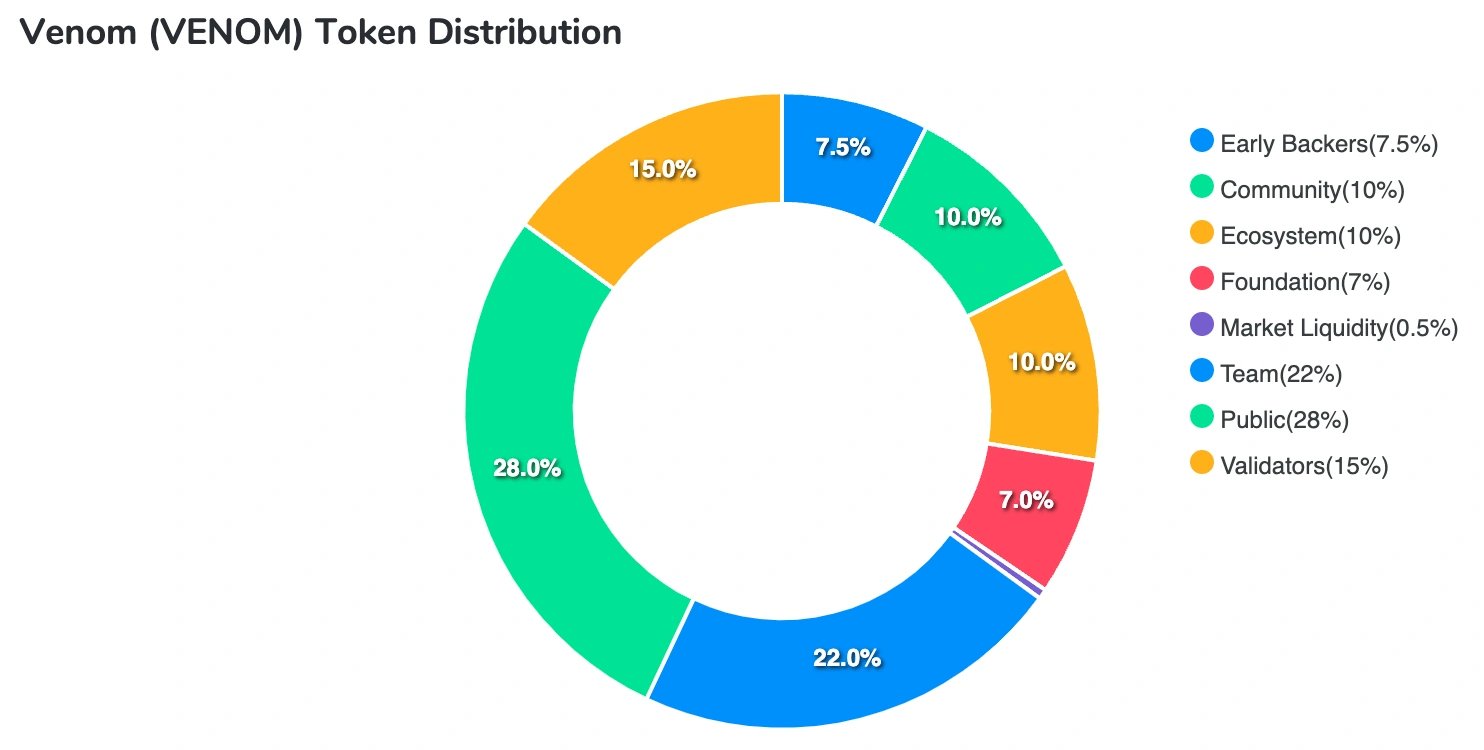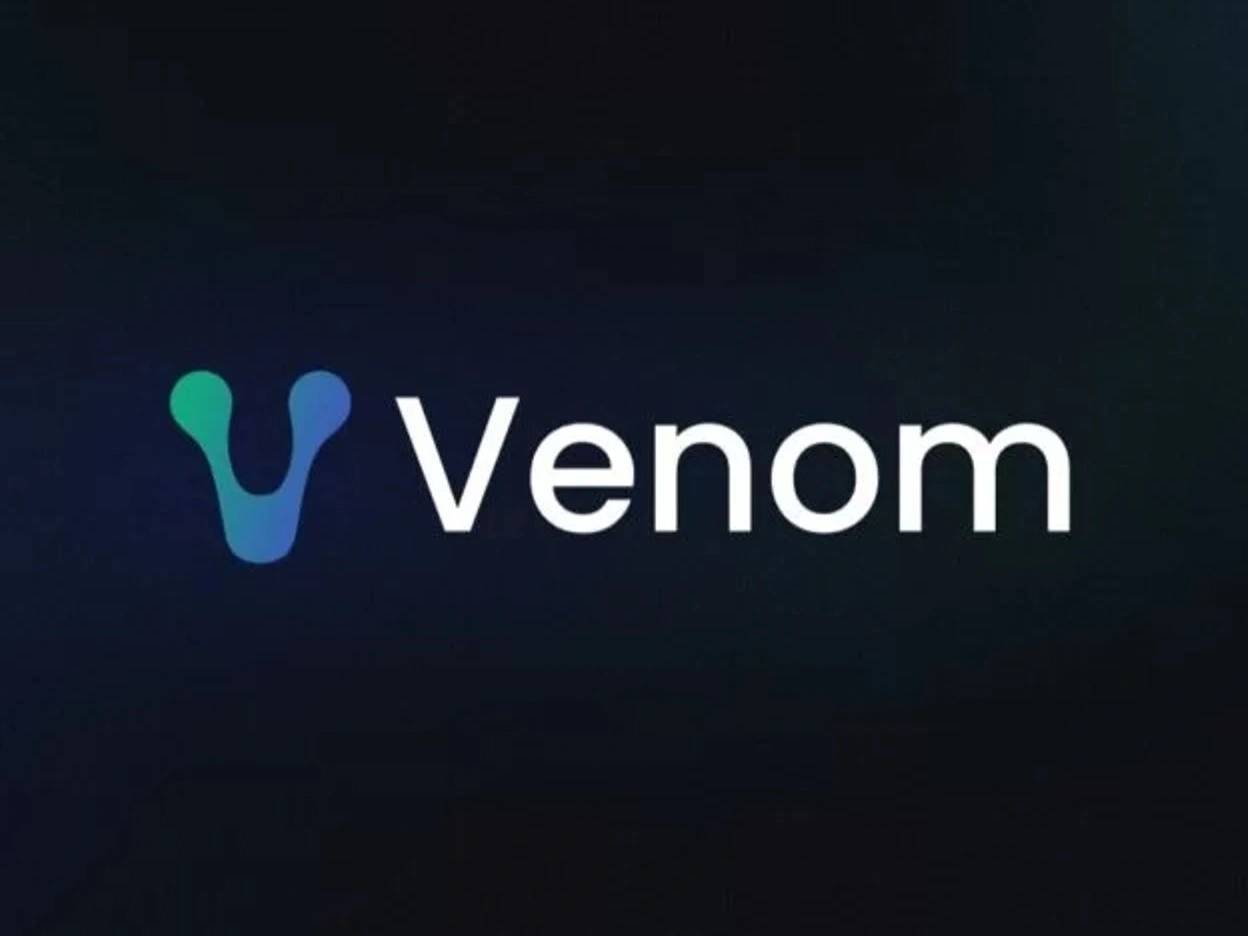위키 구독하기
Share wiki
Bookmark
Venom Foundation
Venom Foundation
**베놈 재단(Venom Foundation)**은 확장성, 보안성, 효율성에 중점을 둔 블록체인 플랫폼을 구축하는 기관으로, 탈중앙화 애플리케이션(dApps) 및 디지털 자산을 위한 솔루션을 제공하는 데 집중하고 있습니다. 기존 블록체인 기술의 한계를 해결함으로써 베놈은 블록체인 기술의 적용을 통해 금융, 공급망, 의료를 포함한 광범위한 산업을 지원하는 것을 목표로 합니다.[3][4]
개요
Venom Foundation은 UAE의 국제 금융 센터인 아부다비 글로벌 마켓(ADGM)에서 운영되는 블록체인(https://iq.wiki/wiki/blockchain) 중심 기관입니다. ADGM에서 최초로 암호화폐(https://iq.wiki/wiki/cryptocurrency) 재단 라이선스를 취득한 Venom은 중동 및 북아프리카(MENA) 지역의 블록체인 인프라 개발에 중요한 역할을 합니다.
재단은 정부 및 기업의 웹3(https://iq.wiki/wiki/web3) 기술 채택 지원에도 중점을 두고 있습니다. Venom은 안전한 거래, NFT(https://iq.wiki/wiki/non-fungible-token-nft) 플랫폼 및 법정화폐 기반 스테이블코인(https://iq.wiki/wiki/stablecoin)에 활용될 수 있는 블록체인(https://iq.wiki/wiki/blockchain) 기반 솔루션을 제공하며, 이는 모두 ADGM의 규제 프레임워크를 준수합니다. 이러한 접근 방식을 통해 Venom은 블록체인 기술의 광범위한 구현을 규정 준수적이고 접근 가능한 방식으로 지원하고자 합니다. [9][10]
Venom 블록체인
Venom은 보안 및 확장성을 향상시키도록 설계된 고유한 합의 메커니즘을 기반으로 구축되어 초당 많은 트랜잭션(TPS)을 처리할 수 있습니다. 이 플랫폼은 다른 블록체인 네트워크 및 기존 시스템과의 원활한 통합을 가능하게 하는 상호 운용성을 중시합니다. 이러한 적응성 덕분에 기업 수준 애플리케이션과 소규모 분산 프로젝트 모두에 적합합니다. Venom은 스마트 계약 기능도 지원하므로 개발자는 블록체인의 고유한 보안 및 투명성을 활용하는 분산 애플리케이션을 구축할 수 있습니다.
Venom Wallet, Venom Scan, Venom Pools와 같은 도구는 분산 애플리케이션(DApps) 생성 및 관리를 용이하게 하고 스테이킹 및 트랜잭션 검증을 포함한 다양한 블록체인 기능을 지원합니다.[1][4][11]
역사
Venom 블록체인의 개념은 2018년 Christopher Louis Tsu(크리스토퍼 루이스 추)와 Kai-Uwe Steck(카이-우베 슈텍) 박사에 의해 시작되었습니다. 두 사람은 아랍에미리트의 투자 그룹과 협력하여 대규모 작업량을 처리할 수 있는 블록체인을 구축하려고 했습니다. 수년간의 개발 끝에 Venom 네트워크는 2022년 4월 클로즈드 테스트넷으로 데뷔했고 2023년 4월에 공개되었습니다. 2024년 3월에는 Venom의 메인넷이 출시되어 주요 거래소 상장이라는 중요한 이정표를 달성했습니다. 이 프로젝트의 핵심 강점은 확장성, 낮은 거래 수수료, 그리고 빠른 처리 기능입니다.
Venom은 현재 Layer 0과 Layer 1 블록체인으로 모두 운영되며, 개발자들이 확장 가능한 Web3 애플리케이션을 구축하고 글로벌 결제에 참여할 수 있도록 합니다. Venom의 아키텍처는 동적 샤딩과 Mesh 기술을 활용하여 분산 금융(decentralized finance) 및 엔터프라이즈 애플리케이션을 포함한 다양한 사용 사례에 맞는 적응 가능한 다중 블록체인 시스템을 제공합니다. [5][6][7][8]
기술
베놈 플랫폼은 확장성과 보안을 향상시키도록 설계된 여러 기술적 혁신을 활용합니다. 주요 기술은 다음과 같습니다.
- 스레드형 가상 머신 (TVM): TVM은 Actor 모델을 사용하여 프로세스를 격리하고 병렬화함으로써 효율적인 계정 상호 작용을 가능하게 합니다. 이 구조는 동적 샤딩을 지원하여 플랫폼의 확장성을 향상시킵니다.
- 합의 메커니즘: 베놈의 합의 메커니즘은 이중 지출 및 51% 공격과 같은 위험을 완화하여 트랜잭션의 무결성을 보장합니다.
- 계정 추상화: 이 기능을 통해 개발자는 스마트 계약을 통해 계정 동작을 정의할 수 있으므로 dApp 설계에서 더 큰 유연성과 모듈성을 제공합니다.
- 외부 메시징: 베놈은 오프체인 및 온체인 시스템 간의 통신을 용이하게 하여 외부 데이터가 블록체인 네트워크 내에서 작업을 트리거할 수 있도록 합니다.
- 워크체인: 이 플랫폼은 다양한 보안, 개인 정보 보호 및 규정 준수 요구 사항을 충족하도록 사용자 지정할 수 있는 특수화된 레이어 1 블록체인 또는 워크체인 생성을 지원합니다.
- T-Sol: Solidity에서 파생된 개발자 친화적인 언어인 T-Sol은 C, C++, JavaScript와 같은 다른 프로그래밍 언어에 익숙한 개발자의 온보딩을 간소화합니다.[3][4]
주요 특징
- 높은 처리량: Venom은 초당 10만 건 이상의 트랜잭션을 처리할 수 있어 대규모 애플리케이션에 이상적입니다.
- 낮은 트랜잭션 수수료: Venom의 트랜잭션 비용은 최소화되어 있으며, 수수료는 일반적으로 $0.0002 미만입니다.
- 상호 운용성: 이 플랫폼은 다른 블록체인 네트워크 및 레거시 시스템과 원활하게 작동하도록 설계되어 데이터 교환 및 협업을 촉진합니다.
- 제로 배출 정책: Venom의 운영은 환경 영향을 최소화하기 위한 제로 배출 방식을 따릅니다.[1][4]
사용 사례
Venom 플랫폼은 다음을 포함한 여러 산업 분야에서 활용됩니다.
- 탈중앙화 금융 (DeFi): 스마트 계약을 통해 안전하고 효율적인 금융 서비스 제공.
- 공급망 관리: 투명성 및 추적 가능성 향상, 공급망 전반에 걸쳐 제품의 진품 여부 보장.
- 의료: 데이터 프라이버시를 보호하면서 환자 치료 개선을 위해 의료 기록을 안전하게 저장하고 공유합니다.[3][4]
Venom 생태계
Venom은 탈중앙화 애플리케이션(dApp), 도구 및 서비스의 성장하는 생태계를 개발했습니다.
- Venom Wallet: 사용자가 자산을 안전하게 관리할 수 있는 비보관 지갑으로, 브라우저 확장 프로그램과 모바일 앱 모두에서 사용할 수 있습니다.
- Venom Scan: 사용자가 Venom 네트워크에서 트랜잭션, 블록 및 기타 데이터를 검색하고 확인할 수 있는 블록체인 탐색기입니다.
- 보조금 및 스테이킹: Venom은 자체 플랫폼에서 개발하는 개발자를 위한 보조금 프로그램과 토큰을 잠금으로써 보상을 받을 수 있는 스테이킹 솔루션을 제공합니다.[3][4]
거버넌스 및 DAO 통합
Venom은 거버넌스 모델에 탈중앙화 자율 조직(DAO)를 통합합니다. DAO를 통해 토큰 보유자는 네트워크에 영향을 미치는 의사결정 과정에 참여할 수 있으므로 중앙 권한에 의존하지 않고 탈중앙화된 거버넌스가 가능합니다. Venom 생태계 내의 DAO는 커뮤니티 프로젝트 관리 및 탈중앙화 투자 기금 감독과 같은 다양한 목적으로 사용될 수 있습니다.[3][4]
Venom 토큰 (VENOM)
VENOM 토큰은 Venom 블록체인의 네이티브 암호화폐로, 분산형 애플리케이션(dApp)(https://iq.wiki/wiki/decentralized-application), 분산형 금융(DeFi) 서비스 및 기타 Web3 이니셔티브를 지원하도록 설계된 확장성이 뛰어난 플랫폼입니다. TIP-3 표준 토큰인 VENOM은 Venom의 분산 시스템에 원활하게 통합되어 비용 효율적인 수수료 모델을 제공합니다. 이 토큰은 거래 수수료 지불, 스테이킹, 분산형 금융 애플리케이션 참여 등 다양한 기능을 지원하는 Venom 생태계의 중추적인 역할을 합니다.[2][3][4][5]
Venom 네트워크의 핵심 구성 요소로서 VENOM은 사용자가 플랫폼의 분산형 애플리케이션에 참여할 수 있도록 하고 생태계 내의 주요 가치 단위 역할을 합니다. 여기에는 스테이킹, 유동성 풀 및 기타 Web3 활동 참여가 포함됩니다.
토큰 경제학
72억 개의 토큰으로 시작하는 VENOM은 트랜잭션 수수료, 스테이킹, 그리고 거버넌스 참여를 통해 네트워크 활동을 지원합니다. VENOM 토큰은 NanoVENOM, MicroVENOM, MilliVENOM과 같은 더 작은 단위로 나눌 수 있어 다양한 트랜잭션에서 유용성이 향상됩니다. [12][13][14][15]
초기 공급 및 배분
메인넷 출시 시 총 공급량의 15.6%(11억 1,600만 개)만 해제되고 나머지 84.4%(60억 8,400만 개)는 잠금 상태가 됩니다. 이 잠금된 부분에는 검증자를 위해 예약된 토큰이 포함되며, 10%(7억 2,000만 개)가 초기 검증자 지분으로 지정됩니다.
VENOM 토큰의 예상 연간 인플레이션율은 -1%로 설정되어 있으며, 이는 약 -7200만 VENOM 토큰에 해당합니다.
VENOM 토큰의 분배는 생태계의 다양한 부문에 걸쳐 균형 잡힌 지원을 보장하도록 구성되어 있습니다:
- Venom 생태계: 28%
- Venom 커뮤니티: 22%
- Venom 재단: 15%
- 시장 유동성: 10%
- 검증자: 10%
- 초기 투자자: 7.5%
- Venom 팀: 7%
- 대중: 0.5%

미래 공급 모델: 인플레이션에서 디플레이션으로
비너스 토큰은 현재 총 공급량 상한선 없이 인플레이션식 공급 모델을 따르고 있습니다. 그러나 비너스 재단은 디플레이션 모델로 전환하는 방안을 모색하고 있습니다. 검토 중인 한 가지 방법은 "수수료 소각"으로, 거래 수수료의 일부를 접근할 수 없는 주소로 보내 영구적으로 유통에서 제거하는 것입니다. 이러한 전환은 네트워크 안정성과 지속 가능성을 유지하면서 생태계 내의 수요와 공급의 균형을 맞추는 것을 목표로 합니다.
베놈(VENOM) 활용 사례
베놈(VENOM)은 베놈(Venom) 생태계 내 다용도 유틸리티 토큰으로 작동합니다. 주요 기능은 다음과 같습니다.
- 거래 수수료: 베놈(VENOM)은 거래 수수료 지불에 사용되어 탈중앙화 애플리케이션의 원활한 작동을 보장합니다.
- 스테이킹 및 거버넌스: 토큰 보유자는 DePools를 통해 스테이킹에 참여하여 네트워크를 보호하고 보상을 받을 수 있습니다. 또한, 베놈(VENOM)을 통해 탈중앙화 자율 조직(DAO)의 거버넌스 프로세스에 참여하여 네트워크의 방향을 결정하는 데 영향을 미칠 수 있습니다.
- DeFi 및 자산 거래: 이 토큰은 베놈(Venom)의 탈중앙화 금융 생태계에서 중요한 역할을 하며, 사용자가 스테이킹, 유동성 제공, 자산 스왑 및 탈중앙화 거래소(DEX)에서의 수익 농사 활동에 참여할 수 있도록 합니다.
- 게임 및 NFT: 사용자는 베놈(VENOM)을 사용하여 블록체인 기반 게임에 참여하고, 대체 불가능 토큰(NFT)을 거래하고, 다른 탈중앙화 애플리케이션과 상호 작용할 수 있습니다.
토큰 표준
베놈의 토큰 인프라는 두 가지 핵심 표준을 기반으로 구축되었습니다.
- TIP-3 (Fungible Token Standard): 이 표준은 VENOM과 같은 균일 토큰의 발행 및 관리를 규정합니다. 이더리움의 ERC-20과 유사하게, TIP-3을 통해 사용자는 토큰을 전송하고, 잔액을 확인하며, 토큰 발행 및 소각하고, 공급량을 추적할 수 있습니다.
- TIP-4 (Non-Fungible Token Standard): 이 표준은 NFT 생성 및 교환을 가능하게 하여 사용자가 베놈 블록체인에서 고유 자산을 발행, 거래 및 관리할 수 있도록 합니다.[2][3][4][5]
WVenom (Wrapped Venom)
Wrapped Venom (WVENOM)은 탈중앙화 금융(DeFi) 프로토콜 내의 호환성을 용이하게 하도록 설계된 TIP-3 표준 토큰입니다. VENOM이 Venom 블록체인의 네이티브 통화로 작동하지만, 많은 DeFi 애플리케이션은 사용 편의성과 스마트 계약과의 상호 운용성을 위해 래핑된 버전의 토큰을 필요로 합니다.
WVENOM은 VENOM을 1:1로 나타내므로 사용자는 DeFi 플랫폼에서 사용하기 위해 네이티브 토큰을 래핑할 수 있습니다. 이 프로세스는 탈중앙화 거래소(DEX) 또는 다른 DeFi 프로토콜과 상호 작용할 때 자동으로 발생합니다. 예를 들어, VENOM을 USDT와 같은 다른 자산으로 스왑할 때, 토큰은 먼저 WVENOM으로 변환된 다음 원하는 자산으로 교환됩니다.
사용자가 WVENOM과 직접 상호 작용할 필요는 없지만, Venom의 DeFi 생태계가 스마트 계약 및 기타 탈중앙화 프로토콜과 호환되도록 하는 데 중요한 역할을 합니다.[2][3][4][5]
잘못된 내용이 있나요?
